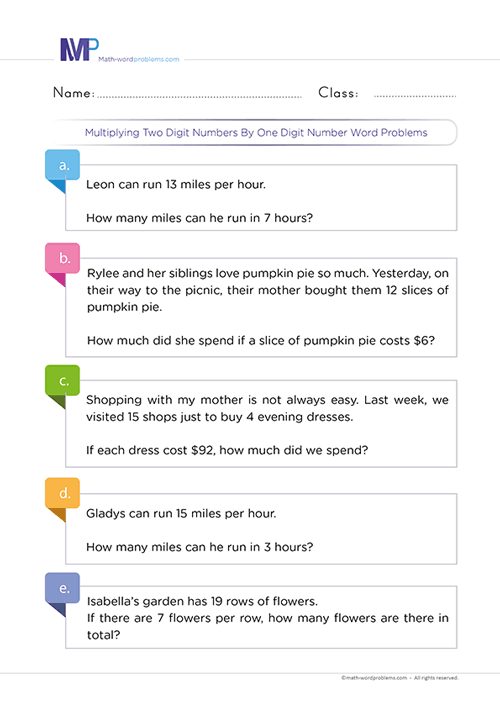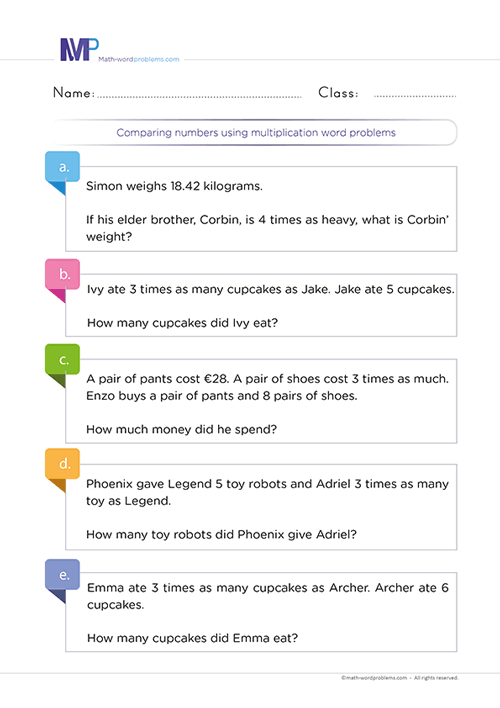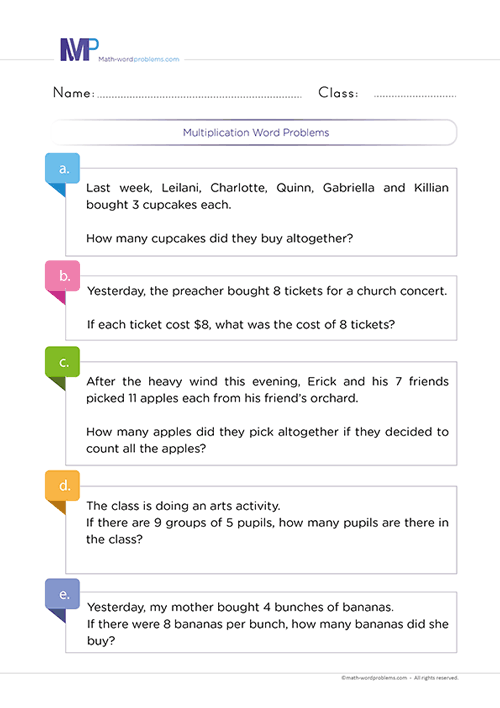 How to multiply two-digit numbers by one-digit number word problems
How to multiply two-digit numbers by one-digit number word problems

- INTRODUCTION
- Step 1 Identify
- Step 2 STRATEGIZE
- Step 3 SET UP
- Step 4 PROVIDE A SOLUTION
- Step 5 CHECK YOUR WORK
Get more contents on this skill...
With this outstanding resource, your 3rd Graders will learn how to multiply two-digit numbers by one-digit number word problems as they go through our procedural instructions and outstanding step-by-step guide.
Also, we will provide essential tips on identifying the problem type, strategizing, and determining the operations. Hence, we hope to enhance your little ones' reasoning and critical thinking skills to determine whether they correctly pair the quantities of the subject and object in the word problems.
Steps on how to solve the multiplication of two-digit numbers by one-digit number word problems
Here are simple steps on how to solve the multiplication of two-digit numbers by one-digit number word problems. These steps will enhance your kids' efficiency and patience in tackling simple and complex multiplication of two-digit numbers by one-digit number word problems.
In addition, these steps involve practical instructional components such as explicit instructions, heuristic techniques, and real-life problems that will enhance kids' problem-solving skills in multiplying two-digit numbers by one-digit number word problems.
These real-life examples of how to multiply two-digit numbers by one-digit number word problems will teach your kids how these unique steps work.
Step 1 IDENTIFY THE PROBLEM
To identify the problem,
- You can begin by studying/reading out the problem carefully to understand it.
- Then, identify and highlight relative statements.
- Now, reread the problem and try to figure out any important numbers and keywords.
Suppose a word problem requires you to perform a multiplication operation. In that case, you will come across one of the following keywords in the word problem: - times, multiplied by, product, the product of, factor, of, multiply, times, multiple, double, triple, groups, by, twice, area, equal groups, every, in all, total, increased by, as much, each, lots of, groups of, per, percent of, the fraction of, etc.
Note: learners should understand that it would be best not to rely entirely on keywords alone because a particular keyword can have different meanings in different word problems.
In that case, you need to read the question very well to understand the situation the word problem describes. After reading, you will also find out if the problem makes sense first before determining which operation you need to use.
Step 2 STRATEGIZE AND DETERMINE THE OPERATIONS
As you move on to this step, ask yourself this pertinent question because it helps, “how will I handle this problem?”
Here, you will have to apply the read-to-understand rule. i.e., you have to read the word problem and try to interpret it in your own words.
Furthermore, since each word problem may require a different solving format, the key points below will enable you to tackle any word problem irrespective of the format.
- First, the keyword(s) in the word problem will help clarify the operation you need to carry out.
- Relying on keywords alone to solve word problems has some limits, as mentioned in step 1 above.
- Hence, you must first read the word problem to understand the situation that the problem is describing.
- Reading the problem to understand it first will lead you to be able to identify the problem type and relative statements in the word problem, which, together with the keyword(s) in the problem, will determine the correct maths operation that you need to use
Step 3 SET UP A NUMBER SENTENCE AND AN EQUATION
- Now, after knowing which operation you will perform from step 2 above, construct short sentences to represent the information given word problem.
- These short sentences represent the vital information that makes it easier to solve the word problem. In order words, it is like a diagram of the word problem.
- After that, you can now deduce a solvable maths equation to represent the information given in the sentences that you constructed above.
Step 4 SOLVE THE PROBLEM
Next, after writing down the maths equation, you can multiply the numbers using regrouping or other methods like long multiplication, grid multiplication, or lattice to determine the result. Remember always to include the unit of measurement in your final answer.
Step 5 VERIFY YOUR ANSWER
Finally, check your work to make sure that your answer is correct. For instance, since you are dealing with only numbers and not algebraic expressions, it is good to use reasonableness by estimation to see if your answer makes sense.
Therefore, if you estimate and the answer is close to what you have, your answer is correct. However, if your answer is beyond reasonable limits, you must go back to step one and start again.
Examples of how to solve multiplication of two-digit numbers by one-digit number word problems
Example One
Step 1:Read the problem and underline all the relational statements. So, after reading, the important numbers that you will find in the word problem are 9 and 78. Also, the keywords that you will find in the word problem are “per” and “total.”
Step 2:Now, the question is, "how will you solve this problem?"
Reread the problem and retell it in your own words to come out with the correct operation without necessarily depending on the keyword.
The problem is saying that Flora has a garden with a certain number of rows and that she has planted a certain equal number of flowers on each row.
So, the problem wants you to find the total number of flowers in the garden.
Now, “which operation can I use to find the number of equal-sized groups and the number of items in each group?”
Back to the given problem, the number of equal-sized groups is the given number of flower rows, and the number of items in each group is the number of flowers per row.
So, you see that, from the situation that the problem is describing, from retelling the problem in your own words, and from the keyword equally found in the word problem, it shows that you have to perform a multiplication operation.
Note that after interpreting the problem in your own words and understanding what the problem is trying to say, you realize that the keyword “total” does not necessarily mean that you should perform an addition operation.
Step 3: Next, construct short sentences representing the most vital information in the word problem.
After that, go ahead and translate the sentence that is in bold below into an accurate solvable math equation.
- Number of rows of flowers in the garden = 78,
- Number of flowers per row = 9,
- Therefore, the total number of flowers in the garden = the number of rows in the garden × the number of flowers per row;
→ 78 × 9 = ?
Step 4: From step 3 above, multiply the numbers using regrouping or any other multiplication methods like long multiplication, grid multiplication, and lattice method to determine the result. Always include the unit of measurement in your final answer.
Using Using the long multiplication method, we have
So, there are 702 flowers in total
Step 5:Finally, check your work to ensure your answer is correct. Since you are dealing with only numbers and not algebraic expressions, it is good to use reasonableness by estimation to see if your answer makes sense.
So, if you estimate and the answer is close to the one you have, then your answer is correct. However, if your answer is beyond reasonable limits, you must go back to step one and start again.
Example two:
Step 1:Read the problem and underline all the relational statements. You see that the important numbers you will find after reading the problem are 98 and 5. Also, the keywords that you will find in the word problem are “each” and “altogether.”
Step 2:Now, the question is, "how will you solve this problem?"
Reread the problem and retell it in your own words to come out with the correct operation without necessarily depending on the keyword.
What is the problem trying to say? Here, the problem is telling you about the game that Milo is playing. It goes further to say that the game consists of different levels and that he scored an equal number of points on each level.
And now, the problem wants you to find the number of points he scored altogether.
So, which operation can you use to find the number of equal-sized groups and the number of items in each group?
Now in the given problem, the number of equal-sized groups is the number of points scored on each level, and the number of items in each group is the number of given levels in the game.
You see that, from the situation that the problem is describing, from retelling the problem in your own words, and from the keywords found in the word problem, you have to perform a multiplication operation.
Note that after you interpret the problem in your own words and understand what the problem is trying to say, you realize that the keyword “altogether” does not necessarily mean that you should perform an multiplication operation.
Step 3: Next, construct short sentences representing the most vital information in the word problem.
After that, translate the sentence that is in bold below into an accurate solvable math equation.
- Number of points Milo scored = 98 points,
- Number of levels in the game = 5,
- Therefore, the number of points he scored altogether = the number of points Milo scored × the number of levels in the game;
→ 98 points × 5 = ?
Step 4: From step 3 above, multiply the numbers using regrouping or any other multiplication methods like long multiplication, grid multiplication, and lattice method to determine the result. Always include the unit of measurement in your final answer.
Using Using the long multiplication method, we have
So, he scored 490 points altogether
Step 5: Finally, check your work to ensure your answer is correct. Since you are dealing with only numbers and not algebraic expressions, it is good to use reasonableness by estimation to see if your answer makes sense.
So, if you estimate and the answer is close to the one you have, then your answer is correct. However, if your answer is beyond reasonable limits, you must go back to step one and start again.





